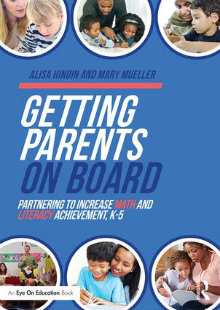Get Parents on Board for Math & Literacy
Getting Parents on Board: Partnering To Increase Math and Literacy Achievement, K-5
By Alisa Hindin and Mary Mueller
(Routledge/Eye on Education, 2016 – Learn more)

If you are looking for ways to connect your classroom or school to parents in nonthreatening, collaborative, and productive ways, you’ll love Hindin and Mueller’s book, Getting Parents on Board.

It is not just that we want parents to be involved but, in my experience, we want them to be involved in ways we carefully lay out for them. We want them to monitor their children’s homework and to back us up at every turn. Teacher want parents do what we tell them to. This book does not push that agenda.
Hindin and Mueller’s work seems to draw heavily from that of Joyce Epstein. Epstein, a professor of education, has developed a framework for describing six types of parent involvement.
Her framework has helped me configure my notion of what it means for parents to be involved. It is highly inclusive and reaches way beyond what is typically thought of by many educators as the gold-standard of parent involvement (volunteering in the classroom, helping students with homework, and disciplining them for poor behavior at school).
What’s in Getting Parents on Board
Epstein does not consider the types of involvement to be hierarchical; each has inherent value and importance. This book gets that. The strategies presented within focus on these four types of involvement:
- Parenting: providing a home environment and supporting students.
- Communicating: two-way communication between parents and teachers.
- Volunteering: parents in the school helping teachers and students.
- Learning at Home: parents as teachers of specific academic content.
The book honors parents and teachers and describes practices for partnership in respectful and doable ways.
The book is broken into four sections, each laden with well-described strategies.
Part I: An overview of why parent involvement is important and how teachers can foster it. This section essentially makes the case that parent involvement matters for student achievement.
Part II: A discussion of the teacher’s role in helping parents be more involved. A key point is that teachers have the ability to promote greater involvement of parents, and that if they do, they, parents, and students will reap the benefits. This section also includes great ideas and information on communicating with parents. From simple newsletters and phone calls or texts home to parent-teacher conferences and family learning events, good ideas are abundant.
This section would have been somewhat stronger if more social media and video communication ideas had been shared. Check out Your School Rocks for ideas about this type of involvement.
Part III: A focus on getting parents involved in students’ literacy learning. Ideas are shared for parent involvement in each of the four areas described above. Hindin and Mueller share examples of informing parents about what students are learning, ideas for parents to use at home to support it, and ideas to extend that learning.
The strategies presented are well-described and most would be very easy to implement. Again, there is a respectful tone, and it is clear that the authors have a sincere desire to support learners through supporting their parents and their teachers.
Part IV: A focus on getting parents involved in students’ math learning. This section does for math what the section above did for literacy. The tables and bulleted lists are fabulous, and frankly, educated me on the new math standards as much as they will educate any parent.
I highly recommend this book to anyone who is interested in increasing parent involvement. Getting Parents on Board ends with a “Final Thoughts” section. The sentence below well sums up the entirety of the book.
If you encourage parents to participate in and out of the classroom by not only inviting them to do so, but also showing the how to support their children, you will have greater success,” (p. 168).
Rita Platt (@ritaplatt) is a Nationally Board Certified teacher with master’s degrees in reading, library, and leadership. Her experience includes teaching learners in remote Alaskan villages, inner cities, and rural communities. She currently is a teacher-librarian, teaches graduate courses for the Professional Development Institute, and writes for We Teach We Learn.



































